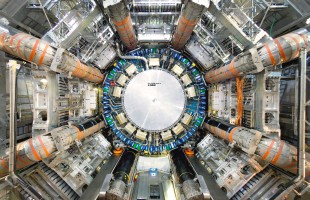For the first time, the ATLAS experiment at CERN has actually measured how long a Higgs particle exists before it disintegrates. The measurement was presented Wednesday at a conference in Pisa, by Nikhef PhD student Michiel Veen.
“This is big,” said Nikhef researcher Ivo van Vulpen, affiliated with ATLAS. “The lifetime is a crucial fact about the Higgs particle. The measurement tells whether we sufficiently understand how the particle decays and whether we might still be overlooking something.”
The measurement is the result of a complex analysis of all the Higgs particles ATLAS has so far observed with the detector in collisions of protons at the LHC accelerator at CERN. The lifetime is derived from the width of the peak of decay products seen by the researchers at a given mass, called the width.
Not sharp
The Higgs particle was demonstrated to exist by ATLAS and others in 2012 at CERN after decades of searching. The particle proves the existence of a field that gives all elementary particles mass, via the so-called Higgs mechanism. Many properties of the Higgs particle are now known, such as mass and spin, but its lifetime was not yet in sharp focus.
The Higgs particle itself has a mass of 125 GeV, about one hundred and fifty times the mass of a hydrogen nucleus. With 4.6 MeV the Higgs width is a narrow peak in the measurements. This width corresponds to an average lifetime of about 1.8 times 10 to the power minus 22 seconds. In that ultra-short time, most higgs particles decay to two Z bosons, which themselves quickly decay further to muons or neutrinos seen in the detector.
Standard model
The width now measured does not indicate the decay of Higgs particles to unknown particles. Within uncertainty, the result is consistent with the 4.1 MeV (1,62 10^-22 seconds) predicted by the Standard Model using all known decay processes. “But you have to know how to measure that before you know for sure,” said Van Vulpen, who is supervisor of Michiel Veen together with Hella Snoek and theoretician Wouter Waalewijn.
The ATLAS measurement also matches the width of 3.6 MeV that the competing CMS experiment at CERN published a few weeks ago. That result was then published in the journal Nature and represented the first ever concrete measurement of the Higgs lifetime.
Before that, experiments such as ATLAS and CMS only knew estimates of the maximum lifetime of the higgs, often dozens of times the width predicted by the standard model. As a result, there was no way to tell whether the true width, if any, deviated from the prediction.
Analytical feat
The analyses required to find the lifetime of the higgs is an analytical feat. The width of the Higgs peak itself can be measured, but it is distorted by measurement errors. To get around these, the flanks of the peak are simultaneously examined. This has to be done indirectly, through subtle quantum effects, because otherwise other processes still give too much background noise. “It is an analysis on the very edge,” Van Vulpen calls it.
Michiel Veen, currently a post-doc for an American university at CERN, looked at one of two possible Higgs decays to Z particles, to two muons and two neutrinos. Together with the work of a group that studied the decay to four muons, that gives ATLAS the first concrete measurement of the higgs width.
Further measurements with the LHC in the coming years will eventually halve the uncertainty in the found lifetime of the higgs, Van Vulpen expects. He does not consider it very likely, but also not to be ruled out, that unknown decay channels will still be found.



